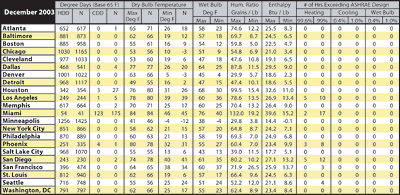

2003 Cooling Season
For many Eastern and Midwestern cities, the 2003 cooling season was mild compared to 2002, having a lesser impact on cooling utility costs. The opposite is true for most Western and Southern cities. However, in some cases (Boston, for example), the latent cooling VLI were higher while degree days were lower. In this case, buildings with large ventilation loads may have experienced higher cooling costs even though degree day data indicates otherwise. Also, 0.4% wet bulb design hours were higher than normal for many coastal cities, forcing cooling towers to work a little harder.2003 Heating Season
The weather had a more severe impact on heating costs compared to 2002 (based on Jan.-Dec.) in Eastern and Midwestern cities, and less of an impact in Western and Southern cities. Note that Detroit is an example where latent VLI data indicates the opposite of degree day and sensible VLI data. So a building with large humidification loads in Detroit may have seen higher heating utility costs even though the sensible heat weather indicators say otherwise. As far as design conditions are concerned, Boston was the only city posting more 99.6% heating design hours than normal.ESNOTES- This report is generated from raw data furnished by the National Weather Service (NWS). Normal max/min and degree day values are from the historical record provided by the National Climatic Data Center (NCDC). ASHRAE design hours are number of hours that meet or exceed the 1997 ASHRAE Fundamentals design conditions. The cooling ventilation load index (VLI) is the total (sensible + latent) energy in ton-hrs/cfm required to maintain 55°F discharge air temperature. Likewise, the heating VLI is the sensible heat energy in Therms/cfm required to maintain 55°. The humidification VLI is the amount of water in gal/cfm required to maintain 30% rh at 70° space temperature.
EDITOR'S NOTE:Due to space constraints, some images associated with this article do not appear on this website. To view them please refer to the print version ofES.

